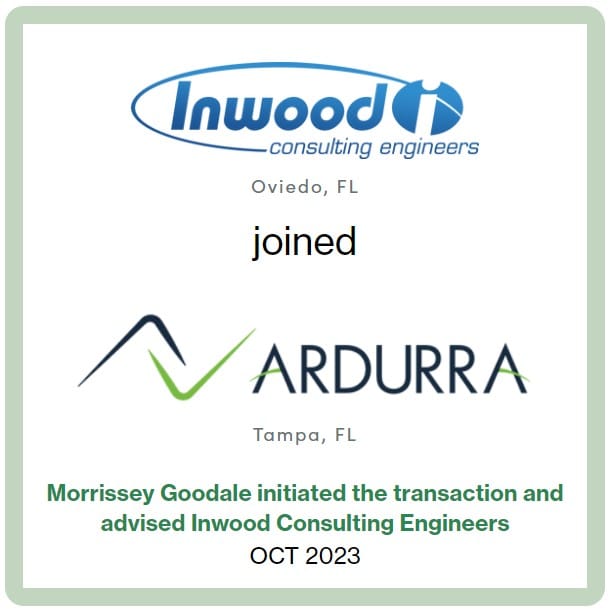Word on the street > Best Post-Transaction Performance Award Recipients and Lessons Learned; 6 Ethical Dilemmas and 5 Ways To Think Them Through
Word on the Street: Issue 170
Weekly real-time market and industry intelligence from Morrissey Goodale firm leaders.

Best Post-Transaction Performance Award Recipients and Lessons Learned
Introduction and context: The 2023 Best Post-Transaction Performance Awards will be presented at the Texas and Southern States M&A, Strategy, and Innovation Symposium in Houston later this month. These are the third of three annual awards in our Excellence in Acquisitive Growth Awards series designed to recognize the most accomplished acquirers in the AE and environmental industry.
We created the awards series for two reasons. First, to recognize those acquirers that are leading the way in improving how consolidation happens in our industry. Second, to share best practices so that collectively the industry achieves better outcomes from M&A in terms of client satisfaction, employee engagement, and value for investors.
Industry consolidation continues at a transformational pace of over 450 transactions a year. So, it’s in the best interests of all industry stakeholders—project owners, firm shareholders, managers, and employees—that consolidation takes place professionally, creating greater value, more stability, enhanced client service, and improved resource allocation.
Performance defined: The Best Post-Transaction Performance Award specifically recognizes those acquirers that have delivered the most meaningful positive business impacts to the firms that they have acquired.
In a first for the industry, this award establishes an objective benchmark to assess post-transaction performance. We developed this benchmark—the Acquisition Performance Indicator (API)—through discussions with executives from industry acquirers and investors—and by leveraging our experience in advising on over 200 AE and environmental firm transactions. The API takes a holistic view of the acquisition. It does not just focus on financial indicators. Rather, it assesses performance in the areas of revenue, profit, backlog, and voluntary turnover in the 12 months following the date of a transaction. The revenue and profit elements indicate top- and bottom-line improvements—and speak to return on investment. The backlog element is an indicator of sales and marketing improvements. The voluntary turnover element reflects improvements in employee engagement and connectivity.
Ideally, acquirers seek to achieve a positive API with each acquisition. And in a perfect world, each contributing factor (revenues, profits, backlog, and voluntary turnover) would be a positive contributing factor. However, only half of the 50-plus applications for the award logged positive outcomes in each of the four contributing factors. This just goes to show it can be very difficult to get everything pointed in the right direction in the first year post-transaction.
We would like to thank all of the firms that submitted applications for this award, and we would like to recognize them for their pursuit of excellence in acquisitive growth. Their intentional commitment to improved performance will result in better outcomes for project owners and firm shareholders, managers, and employees.
The award recipients and honorable mentions: Larger acquisitions have different performance characteristics than smaller ones. So, for this award we have three different size categories. The first is for acquisitions of over $50 million in revenue; the second is for acquisitions of between $10 million and $50 million; and the third is for acquisitions up to $10 million. The award recipients and honorable mentions in each size category are as follows:
• $50 million-plus: The award recipient in this category is TRC (Windsor, CT) (ENR #16) for their November 2019 acquisition of Lockheed Martin’s Distributed Energy Solutions Group (API 1.58). TRC is one of the most prolific industry acquirers, having made 18 acquisitions domestically and overseas since 2018. The honorable mention in this category goes to Trilon Group (Denver, CO) for their June 2022 acquisition of CPH (API 1.49). To date, fast-growing Trilon Group has made a total of 12 acquisitions in the U.S.
• $10 million to $50 million: The award recipient in this category is Salas O’Brien (Irvine, CA) (ENR #54) for their June 2021 acquisition of BVH Integrated Services (API 5.94). Salas O’Brien is one of the most accomplished strategic acquirers in the industry, having made 33 acquisitions since 2018. The honorable mention in this category goes to Atwell, LLC (Southfield, MI) (ENR #74) for their September 2021 acquisition of Waldrop Engineering (API 4.35). Atwell is a prolific industry acquirer, having completed 10 acquisitions since 2018.
• Less than $10 million: The award recipient in this category is Englobe (Montreal, Canada) for their October 2021 acquisition of Protostatix (API 4.58). Englobe is an active acquirer, having made seven acquisitions since 2018. The honorable mention in this category goes to O‘Donnell & Naccarato (Philadelphia, PA) for their 2019 acquisition of McComas Engineering (API 3.91).
Morrissey Goodale will be making a $1,000 donation to an AE industry-related 501(c)(3) organization to be chosen by each of the three award recipients.
By the numbers: Across all size categories, the average API is 2.20, and the median is 1.56. The maximum API is 5.94, and the minimum is negative 0.75. Average API in the greater than $50 million size category is 1.35. All acquisitions in this category are positive. In the $10 million to $50 million size category, the average API is 3.03. Similarly, all acquisitions in this size category are positive. In the less than $10 million category, it’s 1.7. Ninety percent of the acquisitions in this category are positive.
Acquirers excel at creating profits: An examination of each of the four performance indicators that comprise the API (revenues, profits, backlog, and voluntary turnover rates) shows that acquirers are having the greatest success in increasing profits post-transaction. On average, acquirers have been doubling the profits of their acquisitions a year after completing the transaction.
Boosting sales through acquisitions: One of the big lessons learned from this year’s applicants is just how good acquirers are at increasing backlogs through their acquisitions. On average, acquirers have seen the backlogs attributable to their acquisitions grow 44% within a year of the transaction.
Top-line growth: On average, acquirers have been realizing a 33% increase in revenues attributable to their acquisitions one year after completing transactions. When you combine the average increase in backlog at acquisitions (44%) with the increase in revenues, you can see why some firms are spending relatively less on their corporate marketing staff and systems and investing relatively more in their corporate development groups. Simply put, acquisitions are a great way to drive top-line growth.
Let’s put misconceptions to bed now: After almost every industry acquisition, you hear grumblings and warnings from begrudgers and naysayers about how employees are either going to leave or have already left the acquired firm. The data set from these acquirers refutes that. On average, acquirers have been seeing voluntary turnover rates decline by almost one-fifth a year into their transactions. One reason for this is that most acquisitions are creating more opportunities for employees post-transaction. Another is that acquirers are bringing improved benefits to employees at a lower cost to them.
Inferences and lessons learned: Not surprisingly, APIs in the greater than $50 million size category are lower (none exceeded 2.0) than the other two size categories. It’s much harder to drive needle-moving change within 12 months in larger acquisitions. What’s more surprising is the supercharged performance of acquisitions in the $10 million to $50 million range. The acquirers in this category tended to see very solid improvements in all four API elements, which—when combined—created APIs north of 4.0. A negative API does not always indicate a failed acquisition. One firm that reported a negative API realized very positive financial and backlog results overall, and management considered the acquisition a great success. However, due to some tricky principal-related terminations, their voluntary turnover rate resulted in a negative API. Given that the median-sized industry acquisition is around $3.5 million, it’s encouraging to see that 90% of the acquisitions in this size range are positive.
Connections and sharing best practices: If you would like to network with and discuss M&A best practices, representatives from the award recipients and those acquirers with honorable mentions will be attending the Texas and Southern States M&A, Strategy, and Innovation Symposium in Houston later this month.
To contact Mick Morrissey, you can email him at [email protected] or call/text on 508.380.1868.
6 Ethical Dilemmas and 5 Ways To Think Them Through
AE firms are often found in the middle of complex, multifaceted projects that have ambiguous ethical implications. Determining the right course of action can be challenging, especially when services span various industries and require specialized expertise. These dilemmas will often revolve around the intersection of sustainability, technology, social responsibility, and the built environment.
Here are some of the most critical ethical dilemmas AE firm leaders will continue to wrestle with along with thoughts on how to address them:
1. Environmental sustainability vs. economic viability: The imperative to design and construct sustainable, environmentally friendly buildings and infrastructure are typically at odds with economic constraints and cost considerations of clients—and presto, you’ve got your first ethical conflict on the list. Your clients may have different priorities than you. They may prioritize profit margins, return on investment, or short-term financial gains over long-term sustainability. How far firms go in advocating for what they believe is in the best interest of the environment and future generations depends on how strongly they feel a moral and ethical responsibility to create environmentally responsible and sustainable projects.
2. Climate change mitigation and adaptation: Decisions related to building design, materials, and location will increasingly need to address climate change impacts. Ethical questions arise regarding how to prioritize resilience and adaptation efforts. How should we balance the needs and desires of the current generation with those of future generations? How do we prioritize adaptation efforts for vulnerable and marginalized communities? Should resources be distributed evenly, or should they be prioritized based on factors such as population density, vulnerability, or economic value?
3. Resource scarcity and material choices: Choosing building materials and construction methods that minimize environmental impact, such as reducing carbon emissions and minimizing resource depletion, may conflict with traditional practices and cost considerations. AE firms often face ethical conflicts when choosing between cost-effective but environmentally harmful materials and methods and more sustainable, yet potentially costlier alternatives. They must weigh the long-term environmental benefits against short-term financial constraints.
4. Equity and social responsibility: Ensuring that AE projects benefit the broader community and do not contribute to social disparities will be an ongoing ethical challenge. AE firms will have to decide if and how to engage with the communities in which they work, whether that’s conducting community needs assessments, seeking local input, or collaborating with representative organizations to ensure that projects address the community’s specific needs and concerns of residents. Firms may also make decisions about if and how to ensure that the benefits of their projects—such as improved infrastructure, housing, or economic opportunities—are accessible and equitable for all members of the community, including marginalized and vulnerable groups.
5. Data privacy and security: With the increasing use of data and technology, AE firms must grapple with ethical issues surrounding data privacy, security, and the responsible use of data. Collecting and storing data, such as client information, building designs, or construction details, for example, raises ethical questions about respecting the privacy of individuals and organizations and the need to protect sensitive data from people who are not exactly well-intentioned.
6. Technological advancements: The integration of rapidly emerging technologies such as artificial intelligence and automation raises seemingly endless questions about their ethical use, potential job displacement, and the need for responsible technology adoption. For example, how can firms address the issue of bias in AI algorithms and ensure that these systems are fair and do not discriminate against certain groups of people? How can firms make AI and automation systems more transparent so that users can understand how decisions are made, especially in safety-critical applications such as autonomous vehicles or medical diagnostics? How can firms design and implement AI and automation systems in a way that minimizes the negative impact on employment and helps retrain or transition workers displaced by these technologies?
How can your firm effectively address these and other ethical dilemmas the industry will continue to face? Here are five ideas to consider:
1. Devote leadership to it. Create an ethics committee or designate an ethics officer responsible for overseeing ethical considerations within your organization. If they aren’t already, this individual or group will become well-versed in ethical principles and emerging technology trends—and would be responsible for setting the ethical tone for the company.
2. Create awareness. Conduct regular training sessions and workshops to raise awareness about ethical issues related to emerging technologies. Ensure that all employees, from top leadership to back-office support, are well-informed about these concerns.
3. Establish ethical guidelines and policies. Develop clear and comprehensive ethical guidelines and policies that explicitly address the use of AI and automation on projects. These guidelines should cover privacy, bias, transparency, accountability, and other relevant ethical dimensions.
4. Increase stakeholder engagement. Initiate conversations with all stakeholders, including clients, end-users, and affected communities, to understand their concerns and ethical expectations. Consider their input when making ethical decisions and defining project goals.
5. Mitigate risk. Develop strategies for risk mitigation and risk management related to ethical concerns, which may involve setting up contingency plans in cases of ethical violations or adverse consequences.
So, what stance will your firm take on these and other ethical dilemmas in the years to come? How will you decide?
For help incorporating ethics into your AE firm’s strategic plan, call Mark Goodale at 508.254.3914 or email [email protected].
Market Snapshot: Land Transportation (Part 2)
Weekly market intelligence data and insights for AE firm leaders.
Last week’s post featured overview, size, and outlook information about the land transportation market for engineering and construction. If you missed it, you can check it out here. This week we will cover drivers, trends, and hot spots.
Drivers
- Transit ridership and operational performance
- Urbanization and population growth
- Government funding
- Private investments
- Industrial production
- Fuel prices
Trends
- Different aspects of land transportation were disrupted by the 2020 pandemic and, while the market related to the transport of goods has been performing well, mass transit capital spending is still below 2019 levels.
- Recent rail federal funding deployments are focused on improving ADA accessibility at stations. Additionally, investments are being made in fleet replacement in certain markets.
- High-speed rail projects seem to be gaining momentum. There is more public funding available now, but these megaprojects also require significant funding from private sources.
- Railway infrastructure and operations may see an accelerated rate of innovation and technology implementation focused on reducing operational costs and improving service.
- Freight-related transportation structures will continue to be affected by the growth of e-commerce buying habits and by recent shifts in supply chain networks. In addition to increasing network capacity, terminal operators are looking to leverage technologies to improve safety and optimize routing.
Hot Spots
- High-population markets
- Legacy rail systems in New York, New Jersey, Chicago, Philadelphia, Pittsburgh, and Boston
- States with proposed high-speed rail lines: California, Nevada, Texas, Georgia, Oregon, and Washington
To learn more about market intelligence and research services offered by Morrissey Goodale, schedule an intro call with Rafael Barbosa. Connect with him on LinkedIn.
Weekly M&A Round Up

Congratulations to Inwood Consulting Engineers (Oviedo, FL): The 75-person transportation and water firm joined Ardurra Group (Tampa, FL) (ENR #89), a firm that offers consulting and engineering services to public and private entities throughout the United States. With the addition of Inwood, Ardurra further expands its service offerings and presence in Florida. We’re thankful that the Inwood team trusted us to initiate and advise them on this transaction.
Six other domestic deals this week: Last week we reported additional domestic deals in TX, SC, CA, CO, and MI. You can check all of last week’s M&A news here.

Searching for an external Board member?
Our Board of Directors candidate database has over one hundred current and former CEOs, executives, business strategists, and experts from both inside and outside the AE and Environmental Consulting industry who are interested in serving on Boards. Contact Tim Pettepit via email or call him directly at (617) 982-3829 for pricing and access to the database.
Are you interested in serving on an AE firm Board of Directors?
We have numerous clients that are seeking qualified industry executives to serve on their boards. If you’re interested, please upload your resume here.
June 12-14, 2024 Las Vegas, NV
Western States M&A and Business Symposium
Join us for the 10th annual Western States Symposium, bringing together over 200 AE and environmental industry executives and investors in one of the world’s most vibrant and iconic cities.
Learn More
Subscribe to our Newsletters
Stay up-to-date in real-time.










